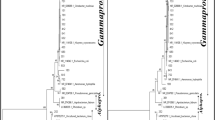Although molecular techniques are considered to provide a more comprehensive view of species diversity of natural microbial populations, few studies have compared diversity assessed by molecular and cultivation-based approaches using the same samples. To achieve this, the diversity of natural populations of ammonia oxidising bacteria in arable soil and marine sediments was determined by analysis of 16S rDNA sequences from enrichment cultures, prepared using standard methods for this group, and from 16S rDNA cloned from DNA extracted directly from the same environmental samples. Soil and marine samples yielded 31 and 18 enrichment cultures, respectively, which were compared with 50 and 40 environmental clones. There was no evidence for selection for particular ammonia oxidizer clusters by different procedures employed for enrichment from soil samples, although no culture was obtained in medium at acid pH. In soil enrichment cultures, Nitrosospira cluster 3 sequences were most abundant, whereas clones were distributed more evenly between Nitrosospira clusters 2, 3, and 4. In marine samples, the majority of enrichment cultures contained Nitrosomonas, whereas Nitrosospira sequences were most abundant among environmental clones. Soil enrichments contained a higher proportion of identical sequences than clones, suggesting laboratory selection for particular strains, but the converse was found in marine samples. In addition, 16% of soil enrichment culture sequences were identical to those in environmental clones, but only 1 of 40 marine enrichments was found among clones, indicating poorer culturability of marine strains represented in the clone library, under the conditions employed. The study demonstrates significant differences in species composition assessed by molecular and culture-based approaches but indicates also that, employing only a limited range of cultivation conditions, 7% of the observed sequence diversity in clones of ammonia oxidizers from these environments could be obtained in laboratory enrichment culture. Further studies and experimental approaches are required to determine which approach provides better representation of the natural community.
Similar content being viewed by others

Explore related subjects
Discover the latest articles and news from researchers in related subjects, suggested using machine learning.Author information
Authors and Affiliations
Rights and permissions
About this article
Cite this article
Smith, Z., McCaig, A., Stephen, J. et al. Species Diversity of Uncultured and Cultured Populations of Soil and Marine Ammonia Oxidizing Bacteria. Microb Ecol 42, 228–237 (2001). https://doi.org/10.1007/s00248-001-0016-x
Received:
Accepted:
Issue Date:
DOI: https://doi.org/10.1007/s00248-001-0016-x



